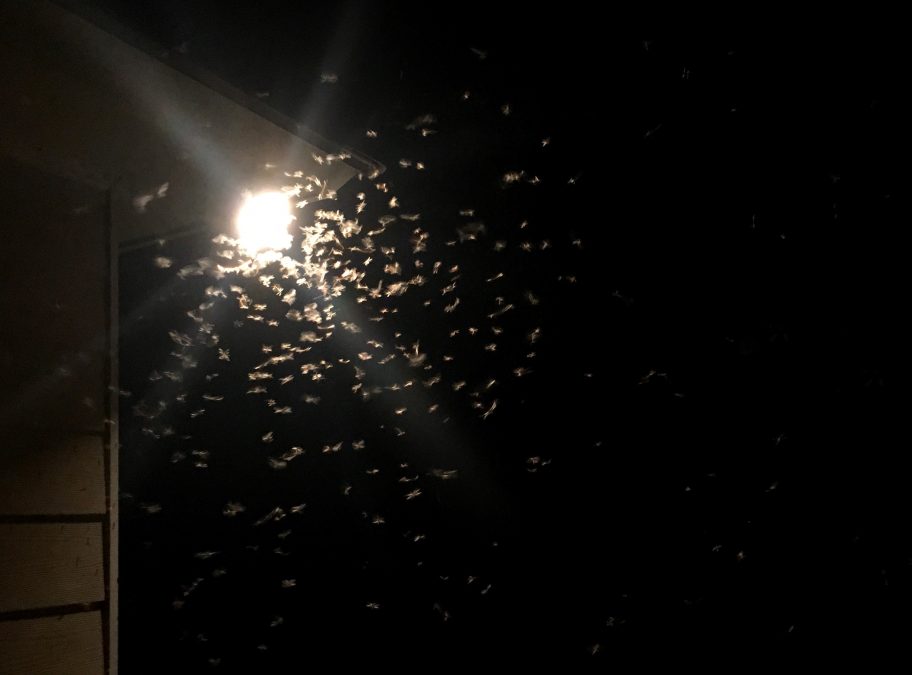
Terrebonne Garden Club celebrates 95 years of beautifying the community
May 1, 2024
Two men arrested in Burglary investigation, spanning Terrebonne and Lafourche
May 1, 2024By Qian Sun
They’re herreeeeee!
When Mother’s Day is celebrated, it is also the time of the year when the Formosan subterranean termites swarm and spread their colonies. The swarm season for this termite starts as early as April and lasts through June, with a peak in early to mid May.
The Formosan subterranean termite is an invasive species and the most destructive structural pest in Louisiana. They were introduced to the continental U.S. from their native range in East Asia via military cargo ships after World War II. In Louisiana, this insect was first reported in the port cities of Lake Charles and New Orleans, and now it has spread to 42 of the 64 parishes, including Terrebonne and Lafourche.
Subterranean termites nest underground and tunnel in soil to search for cellulose-containing materials as food sources, such as dead or live trees, structural lumbers, cardboard, and paper. The Formosan subterranean termites pose a greater threat than the native species, because they form larger colonies, are more aggressive, and build above-ground carton nests. A Formosan subterranean termite colony can have millions of individuals and cause more damage in less time.
What are termite swarmers?
At certain times of the year, termite colonies produce “swarmers”, which are winged adults that fly out of the nest to find a mate and a site to start new colonies. After a short flight and dropping the wings, a pair of female and male run in tandem and search for a suitable nesting site with moisture and food. They mate in their newly dug nest chamber, produce offspring that develop into workers and soldiers, and become the queen and king. In most cases, the swarmers simply die if they cannot find the right environment to dig through and build a nest.
Unlike the native subterranean termites in Louisiana that swarm during the day, the Formosan subterranean termites fly at dusk, and they prefer warm, humid, and windless evenings. Their swarmers are yellowish-brown in color and attracted to lights. They swarm in such large numbers and thousands of termites may be seen hovering around a street light.
What does it mean if you see swarmers?
The swarming termites are not good fliers, and they usually fly no more than half a mile. If you see swarmers outdoors, it indicates an infestation of termites on the nearby trees or structures. It is common for the flying termites to enter homes through the vent, and you may see a few crawling in the bathroom or kitchen. However, if you find these termites flying indoors or notice a large number of wings inside the house, then you quite likely have an active infestation in your home. Termite swarmers do not cause direct damage, and the damage is caused by the workers, which are their offspring that continuously search for and collect cellulose materials. When swarmers are seen, it is important to take proactive measures to protect your property.
What to do to protect your property?
Termite swarmers can be a nuisance when they fly in large numbers, but killing the swarmers in or around the house does not provide much protection from further termite activity and damage. Protecting your home from termites begins with an inspection by a pest management professional, followed by a proper treatment depending on the situation. Because subterranean termites require cellulose and moisture to survive, homeowners can help ward off potential damage by limiting termites’ food and water sources. Here are several actions you can do to protect your home:
- Turn off outdoor lights at night in May and June to avoid attracting swarmers.
- Remove all wood, cardboard, and other cellulose-containing materials from around or under your home.
- Keep mulch 8 to 12 inches from the foundation or perimeter of your home.
- Fix dripping faucets outdoor and repair leaks in the roof or pipes.
- Slope the landscape so water will drain away from the house.
- Use only licensed and certified pest management professionals for termite treatments.
When termite swarms occur, you can collect some of the insects (or their wings) so they can be identified by a pest control service or an entomologist. These specimens can be submitted to LSU Department of Entomology or a local LSU AgCenter Cooperative Extension office.








